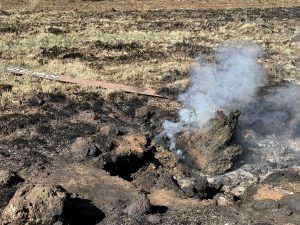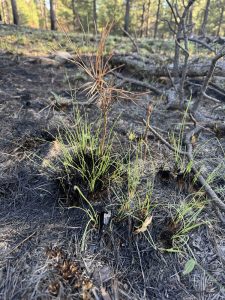 The sight of a giant smoke plume on the horizon is one of those sights that I regard as quintessential Arizona. Having never encountered wildfire before I moved to the state, the idea that a swath of forest or grassland could suddenly be turned to charcoal and ash and threaten towns and lives was new and scary and fascinating all at once.
The sight of a giant smoke plume on the horizon is one of those sights that I regard as quintessential Arizona. Having never encountered wildfire before I moved to the state, the idea that a swath of forest or grassland could suddenly be turned to charcoal and ash and threaten towns and lives was new and scary and fascinating all at once.
So when I was contemplating a walk in the woods a few weeks ago—a long walk, that is, along the Arizona Trail from the Mogollon Rim back home to Flagstaff—I was at first alarmed to see a big plume of smoke rising on a windy afternoon to the southeast, right along the route of the trail. This was the Blind Fire, which had started as a small blaze kindled by a lightning strike, but grown into a much larger fire when Forest Service officials decided to establish a more than 5,000-acre managed fire zone around the initial burned area. Hikers on the trail were told to detour off the trail along forest roads.
 By the time I got to the site five days later, the plume was long gone. I’d already walked across another swath of recently blackened ground where managers had set a 4,000-acre prescribed fire north of the Blue Ridge Ranger Station back in April. Browned needles still hung on the ponderosa branches there. I tried to assess what percentage of branches left green meant the tree would live rather than die. Most of the taller pines looked like they would make it. On the forest floor, bright green sprouts poked out of the blackened stubs of last year’s bunchgrasses. Birds sang in the evening coolness, setting up their nesting territories in the treetops.
By the time I got to the site five days later, the plume was long gone. I’d already walked across another swath of recently blackened ground where managers had set a 4,000-acre prescribed fire north of the Blue Ridge Ranger Station back in April. Browned needles still hung on the ponderosa branches there. I tried to assess what percentage of branches left green meant the tree would live rather than die. Most of the taller pines looked like they would make it. On the forest floor, bright green sprouts poked out of the blackened stubs of last year’s bunchgrasses. Birds sang in the evening coolness, setting up their nesting territories in the treetops.
At the Blind Fire, the detour marked the edge of the burned area. To my right, mingled ponderosas, junipers, and grassy meadows stretched on and on; to my left, the ground was pocked with spotty burn scars where firefighters had created the fire perimeter with their driptorches. Maybe they should be called firetenders instead, to better reflect the fact that the job is at least as much working with fire as working against it? Here and there smoke still billowed from places where a stump had burned out.
It was a novel experience for me to walk unaccompanied along the edge of what so recently had been a vigorous fire. The campfire smell was pleasant, not overwhelming. Groves of green ponderosas stood tall above thoroughly blackened ground. Gambel oaks sprouted leaves as if they’d been indifferent to the nearby flames.
Rounding a curve in the road, I spotted live flames. They were licking at the base of a big yellow pine, finding purchase where the tree’s bark had been damaged just above ground level. This I found worrisome. Ponderosas have famously fire-resistant bark, but they’ll burn readily when the bark is gone.
 I wasn’t carrying enough water to spare any. But I had my shoes. I angled through an oak thicket and began kicking dirt on the tree’s base. At first the flames flared up more. I kicked some more, cutting off the fire’s oxygen. As my shoes and legs blackened with dust, the flames disappeared, and only stray wisps of smoke remained.
I wasn’t carrying enough water to spare any. But I had my shoes. I angled through an oak thicket and began kicking dirt on the tree’s base. At first the flames flared up more. I kicked some more, cutting off the fire’s oxygen. As my shoes and legs blackened with dust, the flames disappeared, and only stray wisps of smoke remained.
Maybe I’d saved a yellow pine. Maybe tanagers or wood pewees would nest in it, next year or in decades to come. Maybe it would again and again over the course of its long life have the opportunity to experience flames racing along the ground, consuming grasses and fallen needles and sprouting pines but leaving the high branches alone. I liked to think so.
A bit dirtied, but pleased, I walked on, feeling new appreciation for the hard work of tending fire, of sniffing for smoke, of moving earth around, of deciding when to intervene and when to leave well enough alone. At a time when many Americans would agree that so many many things are going wrong, it is important to recognize where things are going right. And one of those places is right here, in the ponderosa forests around Flagstaff, where for years and decades the firetenders have learned to use fire to shape the forest—to fight it with all means necessary sometimes, yes, but also to light things up when conditions suggest that the fire will stay mainly on the ground, to encourage the mainly open-structured forest that stores carbon in durable tree trunks. To re-welcome fire as a constituent of place almost as regular as winter snow and summer rain, and as a primary expression of how people can live well in their place.

